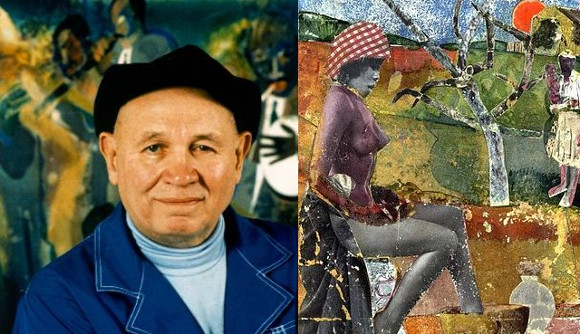
One of the major contributors to the world of art and literature, Romare Bearden, was born on September 2, 1911 in Charlotte, North Carolina. During the 76 years that he spent in this world, Bearden showed remarkable flair in the fields of music, performing arts and history, including art and literature.
Starting college at Lincoln University followed by a transfer to Boston University, Bearden finally completed his studies at New York University, graduating with a degree in education. During his time at NYU, Bearden opted for art courses and served as a lead cartoonist and eventually art editor for the monthly journal, The Medley. He had also been the art editor for Boston University’s Beanpot.
While still a student, Bearden published numerous journal covers and texts showing his concern for the social and artistic issues. Attending the Arts Students League in New York and the Sorbonne in Paris, the young enthusiast became a weekly editorial cartoonist for the Baltimore Afro-American in 1935.
Joining the Harlem Artists Guild, Bearden set out on his journey of studying art which was to last a lifetime, seeking insight from a range of artists including Picasso, Giotto and Duccio. Bearden also gained inspiration from African sculptures, Byzantine mosaics, Japanese prints and Chinese landscape paintings.
From the 1930s to the 1960s, Romare Bearden worked as a social worker with the New York City Department of Social Services, devoting his nights to work on his art. His skill in the latter field was recognized at his first solo art exhibition in Harlem in 1940 after he joined the art group, The Spiral, and his first individual show took place in Washington in 1944.
Due to his exceptional work, Bearden soon became renowned for his creative and unique pieces. Experimenting with various mediums and artistic styles, he was best recognized for his richly textured collages, two of which featured on the covers of Fortune and Time magazines in 1968. Branching out his talents and interests to various fields, Bearden also designed costumes and sets for the Alvin Ailey American Dance Theatre and Nanette Bearden’s Contemporary Dance Theatre.
Bearden was also a valued writer and an ardent spokesman on artistic and social issues and was an active member of many art organizations. In 1964, he was appointed the first art director of an African-American advocacy group, Harlem Cultural Council. Bearden was associated in setting up several prominent art venues including The Studio Museum and the Cinque Gallery and later co-established Cinque to assist younger minority artists. The artist was also one of the founding members of the Black Academy of Arts and Letters in 1970 and was elected to the National Institute of Arts and Letters two years later.
Amongst the writer’s famous publications are: A History of African American Artists, The Caribbean Poetry of Derek Walcott and the Art of Romare Bearden and Six Black Masters of American Art. Bearden’s work is included in various important public collections such as the Metropolitan Museum of Art, the Museum of Fine Arts and the Whitney Museum of American Art. He also had retrospectives at places like the Mint Museum of Art and his posthumous retrospectives were seen in the National Gallery of Art, Washington.
Included in the many awards and recognitions which Bearden received are the honorary doctorates presented to him by Pratt Institution and University of Atlanta, among others, and the Mayor’s Award of Honor for Art and Culture in New York City in 1984. Receiving the National Medal of Arts from President Ronald Reagan in 1987, Romare Bearden passed away the following year on March 12, 1988 while his art continues to live and inspire individuals even today.
